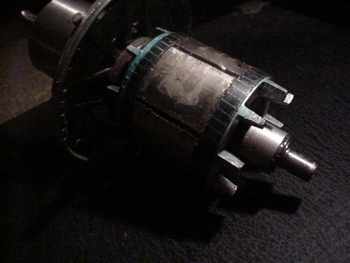Messing with wind turbines has been somewhat of a hobby for me for about 20 years. We've always lived off the power grid since 1970 (I was 3 then). For several years during the '70's we had battery radios and kerosene lamps. At some point, my folks started using a car battery and we had a 12 volt reading light (cleverly built by my mom from tail light fixtures and 1X2's) in every room of the cabin. They'd swap car batteries between the house, and the car every time they went to town. Then in the late 70's they purchased a 6' diameter 200 watt 'Wincharger' which worked out well. After high school I moved to my own cabin and started messing with wind turbines using Ametek tape drive motors. They worked pretty well along with 2 solar panels I had, it was plenty for a couple lights and a radio. A little over 5 years (1999) I started trying to build low rpm alternators from scratch and started documenting most of my efforts on webpages. Lots of fun.. lots of bad designs and lots learned. This page is sort of a brief diary of those projects with some added comments and afterthoughts about all those fun projects along the way.

I built the machine pictured above about 6 years ago. It was an attempt at a dual rotor alternator using common magnets from computer hard drives. Not a very good design... not very much power, and lots of cogging! Fun and educational though - and as soon as I put the web page up I got lots of constructive critisism via email. There's a page about that project HERE.
Shortly after starting this website (otherpower.com) I started messing at 'converting' induction motors by putting magnets into the rotor. I was surprised what an easy way this was to make a low rpm alternator. The first one I made we put on an old 10 speed bike and it made a pretty effective 'pedal' generator.
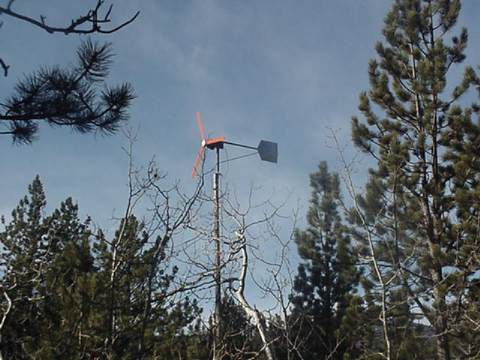
I made the machine above a little over 4 years ago, shortly after we started this website. It had a 6.5' prop and a 'converted' 2hp induction motor. When I did this I veiwed things a bit differently... I misunderstood how a furling system works, I felt a bit more optimistic about 'normal' winds. We also used a lot less power than we do now. This machine had issues with cogging as do many induction motor coversions - although some folks on our discussion board seem to have sorted that out now. Overall though - this machine worked out allright and I believe it flew for a few months.
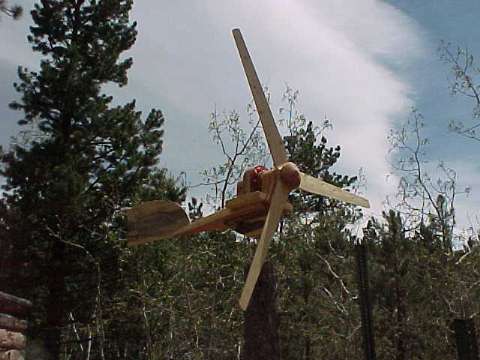
South West Windpower's 'Air 403' was so popular I decided to name this one the 'Wood 103'. It was a quick fun project and perhaps my 2nd attempt at building a 'workable' alternator from scratch. It was inspired after doing a few induction motor conversions... basicly I was trying to build the same thing out of wood. It would've worked a lot better had I used some iron in certain places (like under the magnets). But it worked surprisingly well anyhow. Initially, it was just an alternator project, I had no intention of building a wind turbine. But it worked well enough to justify carving a quick set of blades for it. Theres a page about that HERE.
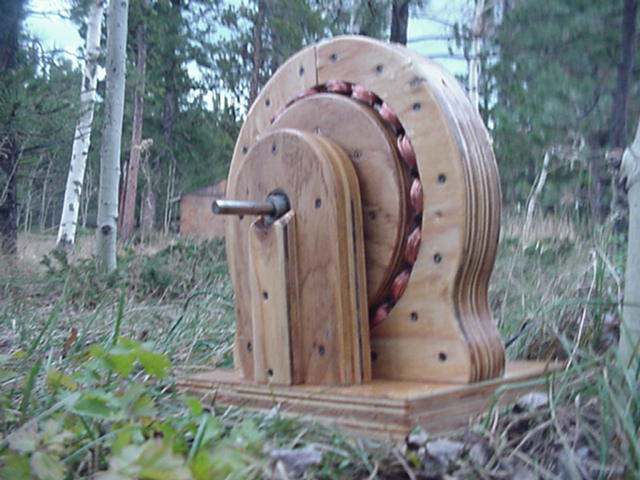
After building the 'Wood 103' I decided to scale that up a bit. This uses basicly the same magnets, and similar coils. Again - it hurts it badly not to have iron behind the magnets or laminates behind the coils. It does go to show though... if you throw enough magnet at the problem you can make almost anything work no matter how badly it's designed! Lots of fun... The page about this one is HERE. I never made a wind turbine out of this.. the wooden frame wouldn't have held up for long. It sits at our store hooked up to some meters, a switch, and a light bulb for kids (of all ages) to play with.
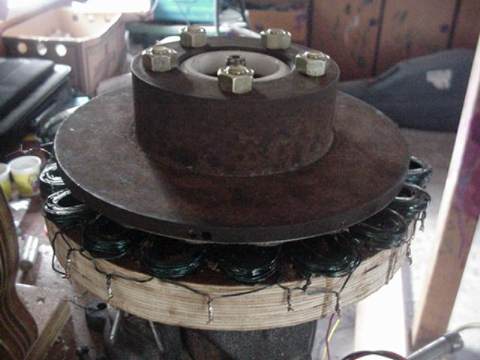
After building the large wooden alternator, I figured it'd be easier to go with an axial flux machine. Ward (my longtime freind and neighbor) wanted to build a wind turbine, so I enlisted his help and we built the first 'Volvo Brake disk alternator'. This was a big improvement over the wooden one in that it had a reasonably good magnetic circuit. The magnets are mounted to a steel rotor, and there are laminates behind the coils. The laminate material I used was 'annealed' bandsaw blade - not a very good choice, the drag on this alternator was signficant. We used fairly thin magnets, so the resistance in the coils was fairly high in order to get good voltage at low rpm. Theres a page about building this HERE.
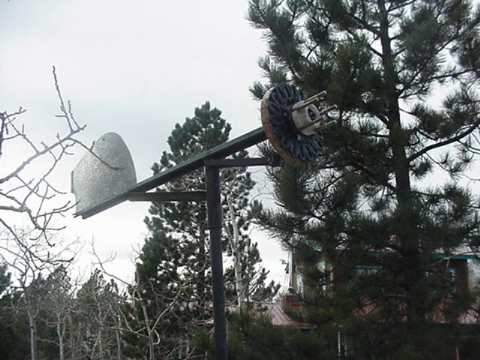
We built Wards wind turbine from the previously discussed alternator. No furling system. There were several failures with this machine in the first month or two. The first failure was in rasing it... we forgot to fasten the guy wire on the west side. DanF made a great page about that Here. The tail fell off twice. (the first one was sheet metal, the 2nd one was an old sawmill blade, the 3rd one is plywood and still works fine), It oversped a bit, so we doubled up the magnets in it to get the speed down. This worked great, till a high wind came (120 amps) and the magnets flew out and hit the blades like bullets. One time the blade blew up when the tail fell off and it yawed very quicky. The last failure on this machine was perhaps 2 years ago when time, and vibration (its a single phase machine and vibrates intensly) caused the laminates to pull loose from the plywood stator causing coils to hit magnets. We fixed that by replacing the stator and building it stronger with lots of resin and fiberglass cloth. Surprisingly... this machine has been pretty trouble free over the last 3 1/2 years except for a bad spell there at the beginning. We learned a lot from it. Ward and I just(Jan 2005) finished a brand new 'dual rotor' 10 diameter machine with a 3 phase alternator and a furling system to replace his old one with, so we'll be taking this one down within the week. It's served him well though - while it doesnt start very easily and is a bit precarious in high winds and isnt very efficient... it has provided lots of electricity for him over the years. There is a page about the machine itself HERE.

I built this one for myself shortly after finishing Wards. It worked pretty well and never had a problem - perhaps for 6 months, at which time I built a larger 9' version of it, but I never got a webpage up about that one. The 9' machine had problems due to the lack of a furling system. Both of those machines have since been cut up so we could use the strut/spindle parts on better dual rotor machines... so they've been recycled. There is a page about it HERE.
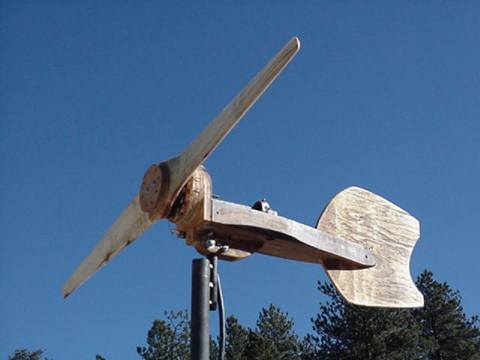
We named the 'Wood 103' after the popular 'Air 403'. Then I built this little machine pictured above about the time SW Windpower came out with their 'Air X' (so we named this one the 'Wood Axe'). Like Wards, and mine.. it was a single rotor axial flux, single phase machine with a 4' 2 blade prop. It didn't startup very easily, partially due to drag in the laminates, but mostly due to the 3/4" shaft and the stiff ball bearings. Once it was going... it did reasonably well. The page about this machine is HERE.
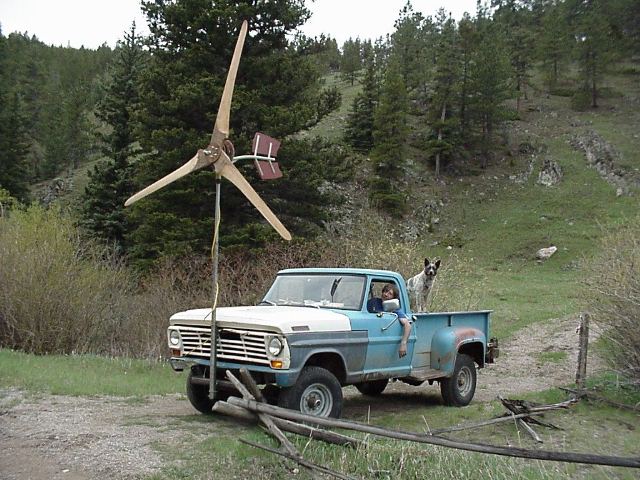
DanF and I attended Hugh Piggott's Seminar on Guemes Island in April 2003. I built the machine above as soon as we returned. I built it with intentions of possibly converting it into a dual rotor machine, so it has a cast stator. The steel laminates are nice silicon steel that I got from Ed at Windstuffnow.com, and they are simply 'stuck' to the back of the stator via the attraction of the magnets alone. After I cut the prop down to 9' diameter, this machine did a really nice job and ran pretty efficiently. I used it from May of 2003 untill January of 2004 when I rebuilt my tower and put up a much more powerful, 14' diameter dual rotor machine. It's still stored under my shop, I believe one of my neighbors will be using this 9' machine soon. There is a page about building this machine HERE.
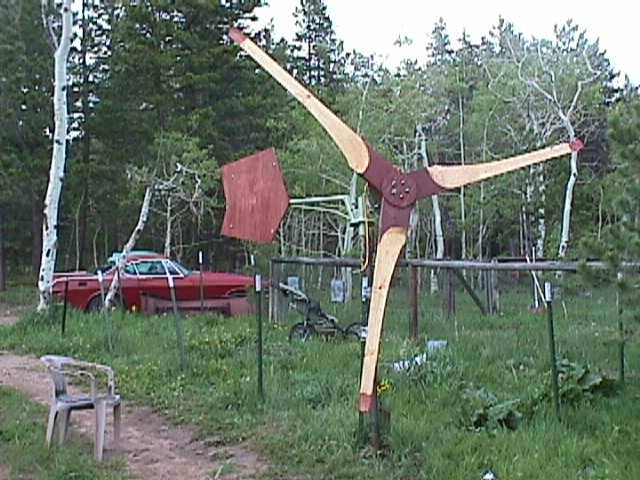
About 1 week after finishing the 9' single rotor machine above, my freind Dave and I started work on a dual rotor 3 phase wind turbine to power his Caboose. This one, like several others to follow... had a cutin speed a bit on the low side, and the alternator was a bit too powerful for the 10' prop. It's not a big issue for him though, because it's a 12 volt machine with over 300' of line between it and the batteries. The line adds some 'sponge' to the system and it works pretty well. It's been up over a year and a half producing lots of power with no problems yet. It's the first of many nearly identical machines we've made up here. There's a page about it's construction Here.
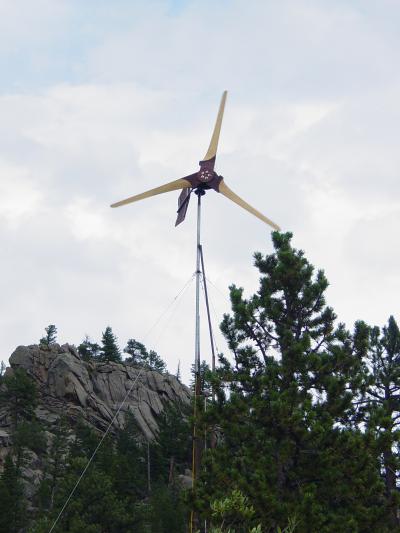
Perhaps a month or so after we got Dave's installed above the caboose, DanF, TomH and I built 3 identical machines - basicly identical to Dave's but a bit nicer. So far only Tom has put his up.. DanF is still building a tower and the 3rd one should go up soon, the tower is finished. These machines need the airgap opened up a bit to raise cutin speed, and a bit of resistance added to the line to bring the power curve down to a reasonable level for a 10' prop. Another solution (my neighbor Scott took this route) is build a larger prop. With an 11' prop, the alternator seems a good match. One other drawback with these - I wired them all in Delta. There are minor losses with that. These are the last 3 we wired that way, later machines are wound with fewer windings, heavier wire... and wired in Star. I also use smaller magnets now for the 10' machines. After we built these 3, I made a fairly detailed set of pages about their construction HERE.

In the fall/winter of 2003/2004 I had 3 other neighbors come up and build 10' diameter machines. All of them are up and running and have been quite reliable with only one exception (mostly due to tower failures). In these, as mentioned above - we wired the stator in Star and changed the coils a bit. There is a fun page about these machines HERE.

I started this machine on Thanksgiving day in 2003. I built the tower and got the machine up in January of 2004. The only problem it ever had was at the top of the yaw bearing, which wore through. There needs to be some kind of bushing/bearing between the top of the tower and the top of wind turbine. In March of 2004 I started a 2nd one like it, which we got finished and raised on MattB's property in June. Mine ran reliably for a bit over 1 year, and Matt'B's 15' version is almost 2 years old and it's been trouble free. There is a 3rd one for my freind Dennis which is completed except for the blades and the tower... it's moving slowly, perhaps we'll have it up by springtime. Mine ran for a bit over a year before I replaced it with a larger experiment. There is a page about these machines HERE
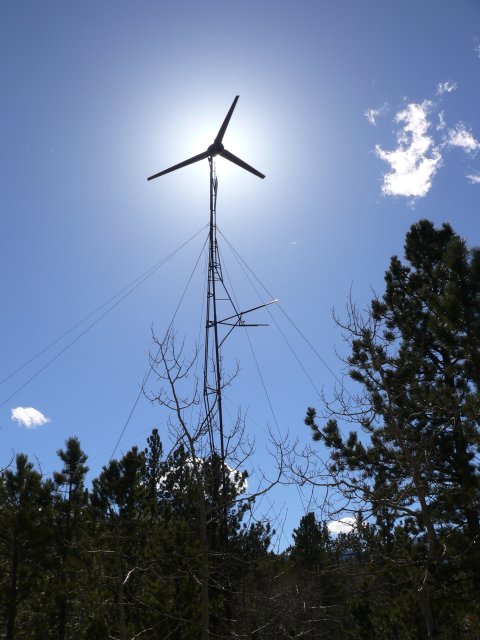
This machine went up in Feb of 2005 and at the time of writing this it's still operational. Overall it's been pretty reliable although I have had some problems and it's been repaired a couple of times. There is a page about this project Here. This machine is large enough that 12 volts was no longer practical, so I upgraded our entire system to 48V. It cuts in nicely in very low winds and peak output I've seen from it is about 6.5KW, although it seems quite happy to do around 3KW sustained output on breezy days.
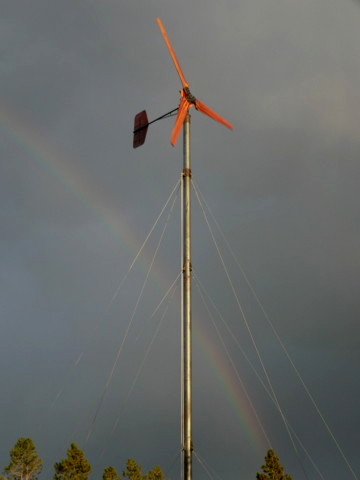
This machine we finished in July 2006. It's 20' diameter and sits on a 75' tilt up tower made from 10" diameter tubing. This starts charging our batteries at 65 rpm and seems quite happy to produce 3KW. We could probably get more in higher winds if we make the tail a bit heavier, it furls early. Adding a bit of resistance to the line would also let the blades run a bit faster in higher winds and increase output, but as it is it's excellent in low winds and overall it produces more power than we can use. I prefer to keep it slow/quiet and safe and 3KW is more than enough for our needs. There is a page about that machine HERE.

And, be sure to check out our book Homebrew Wind Power for more small wind power information!
We've built several since... mostly 10' diameter dual rotor machines, I think the design is fairly well sorted out. It's very much along the lines of Hugh Piggott's axial flux design. Right now we're working on #44 since May 2003 (I didn't count any before that...). Most of the folks living up here have built (or helped to build) one and most have got them flying. We've sold a couple...
Lots of fun, it's been a fun learning curve which has been helped along greatly by the folks on our discussion board, the community there is amazing. Hopefully a couple years from now we'll all still be moving foward with it.

